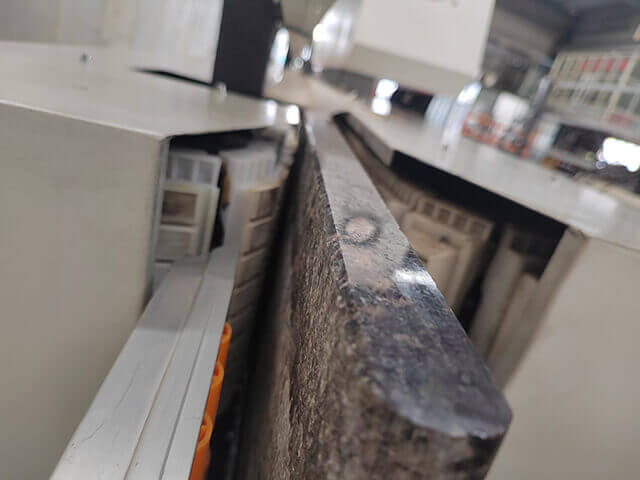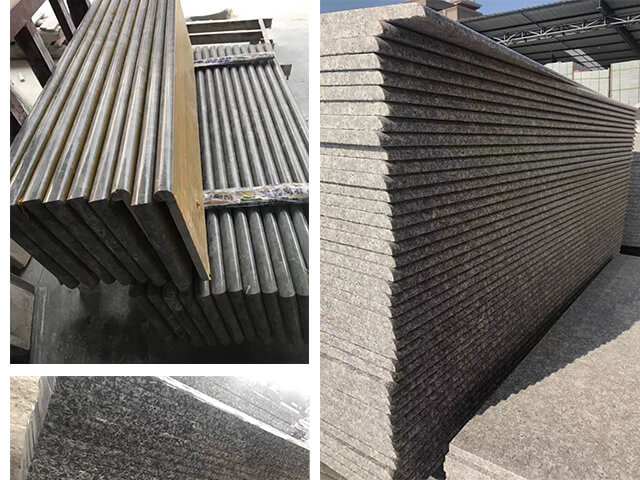Author:Dafon Kerbstone Machine FROM:Stone Machine Manufacturer TIME:2024-08-24
Yes, you can polish granite with a grinder. However, you'll need to use specific diamond polishing pads designed for granite. These pads come in various grits, from coarser to gradually finer ones, to achieve a smooth, polished finish.
Here's a general outline of the process:
Choose the Right Grinder and Attachments:
Grinder: Use a variable-speed angle grinder, which allows you to control the speed and prevent overheating.
Polishing Pads: You'll need diamond polishing pads of different grits (e.g., 50, 100, 200, 400, 800, 1500, 3000). Start with a lower grit and work up to a higher one for a smoother finish.
Backing Pad: Attach a flexible backing pad to the grinder to hold the polishing pads in place.
2. Prepare the Granite Surface:
Clean the granite thoroughly to remove any dirt, dust, or debris.
If there are any deep scratches or chips, you may need to use a coarse grit pad (e.g., 50 grit) to grind them down before starting the polishing process.
3. Polishing Process:
Start with Low Grit: Begin with the lowest grit polishing pad (e.g., 50 grit) to remove rough surfaces and scratches. Apply light pressure and keep the grinder moving to avoid gouging the stone.
Progress Through Grits: Gradually work through the grits, moving to a higher grit pad after each pass. Each grit level should be used to remove the scratches left by the previous grit.
Keep the Surface Wet: To prevent overheating and dust generation, use water while polishing. Some grinders have a water attachment, or you can manually apply water to the surface.
Polish Until Desired Finish: Continue polishing with higher grits until you achieve the desired finish, whether it’s a honed, semi-gloss, or high-gloss finish.
4. Final Buffing:
Once the polishing is complete, you can use a buffing pad and granite polishing compound to give the surface an extra shine.
Using a grinder for polishing granite is effective for small or irregularly shaped pieces. For large-scale or commercial projects, a professional stone polishing machine might be more efficient.

Grinders and polishers are both tools used in surface finishing, but they serve different purposes and are designed differently to handle specific tasks. Here’s a breakdown of the key differences:
1. Purpose and Function:
Grinder:
Purpose: Grinders are primarily used for cutting, grinding, and shaping materials like stone, and concrete.
Function: They use abrasive wheels or discs to remove material quickly. Grinders can be used to roughen a surface, remove burrs, or cut through hard materials.
Polisher:
Purpose: Polishers are designed to smooth and shine surfaces, typically used on materials like stone, and automotive finishes.
Function: They use softer pads or polishing discs with finer abrasives to create a smooth, glossy finish on the surface. Polishers are used for finishing work, where the goal is to achieve a high-gloss or mirror-like appearance.
2. Speed and Power:
Grinder:
Speed: Grinders typically operate at higher speeds (measured in RPM, or revolutions per minute) to efficiently remove material.
Power: They are more powerful to handle heavy-duty tasks like cutting or grinding through tough materials.
Polisher:
Speed: Polishers operate at lower speeds compared to grinders, which allows for better control and a finer finish without causing damage to the surface.
Power: They are generally less powerful, as they are not intended for heavy material removal but rather for surface finishing.
3. Design and Attachments:
Grinder:
Design: Grinders are designed with a focus on durability and power, often featuring a more robust build.
Attachments: They use abrasive discs, grinding wheels, or cutting wheels. The discs are usually made of tougher materials like carbide or diamond.
Polisher:
Design: Polishers are designed to be lighter and easier to control, which is important for achieving a uniform finish.
Attachments: They use polishing pads, foam pads, or buffing pads that can hold polishing compounds or waxes. These pads are usually softer to avoid scratching the surface.
4. Control and Precision:
Grinder:
Control: Grinders are less precise due to their higher speed and power, making them better suited for rough work.
Precision: Not ideal for tasks that require fine finishing or smooth surfaces.
Polisher:
Control: Polishers offer better control, especially at low speeds, making them ideal for detailed work.
Precision: Excellent for achieving smooth, even finishes without damaging the material.
5. Applications:
Grinder:
Commonly used in metalworking, construction, and fabrication for tasks like cutting, grinding, and shaping hard materials.
Polisher:
Used in automotive detailing, stone finishing, woodworking, and metal polishing to achieve a high-gloss finish.
Summary:
Grinders are heavy-duty tools designed for removing material quickly and efficiently through grinding or cutting.
Polishers are specialized tools designed to create smooth, shiny finishes on surfaces, with a focus on precision and control.
In some cases, a grinder can be used for polishing if it’s equipped with the right attachments, but dedicated polishers are generally more suitable for achieving a high-quality finish.

Yes, you can use an angle grinder on granite. However, you'll need to use specific diamond-coated grinding discs designed for stone. These discs come in various grits, starting from coarser grits to gradually finer ones, to achieve the desired finish.
Here's a general process:
Prepare the granite: Ensure the surface is clean and free of debris.
Start with a coarser grit: Begin with a lower grit diamond disc (e.g., 50-grit) to remove any deep scratches or imperfections.
Progress to finer grits: Gradually move to finer grits (e.g., 100, 200, 400, 800, 1500, 3000) to achieve a smoother finish.
Use water or a lubricant: Some diamond discs require water or a lubricant to work effectively. Follow the manufacturer's instructions.
Important safety tips:
Wear protective gear: Always wear safety glasses, gloves, and a mask when using an angle grinder.
Avoid excessive heat: Overheating can damage the granite. Take breaks to allow the stone to cool down.
Follow manufacturer's instructions: Adhere to the specific instructions provided with your angle grinder and diamond discs.